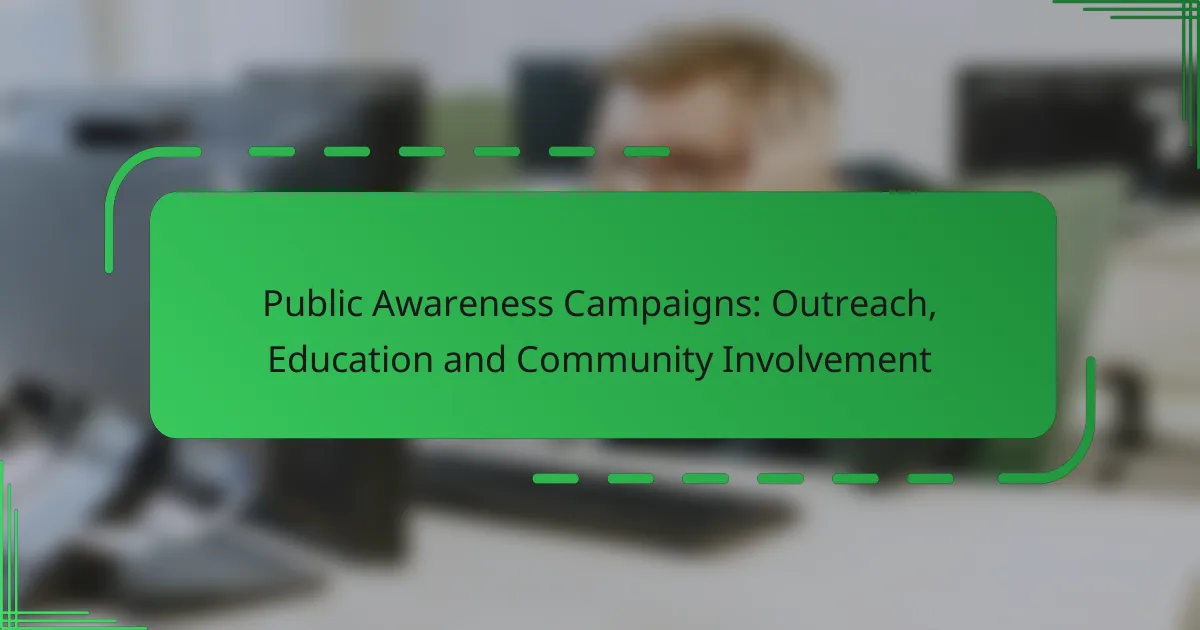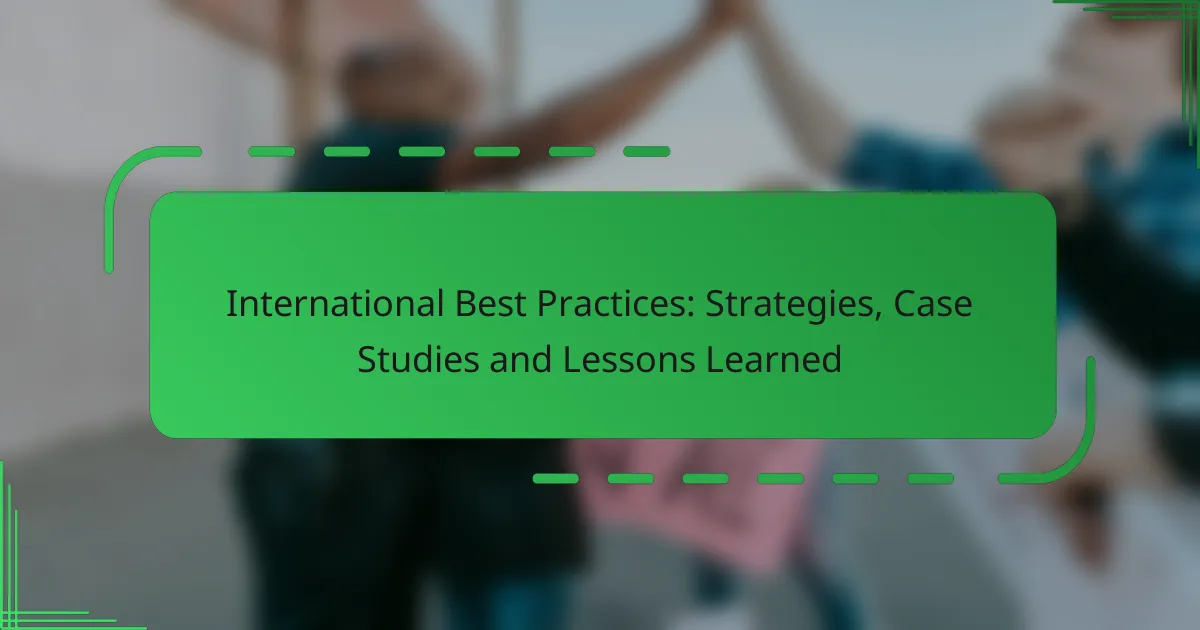Public awareness campaigns play a crucial role in enhancing community engagement by fostering participation and improving communication among residents. By utilizing tailored outreach strategies and educational initiatives, these campaigns inform and motivate individuals to actively contribute to local initiatives, ultimately creating a more connected and informed community.
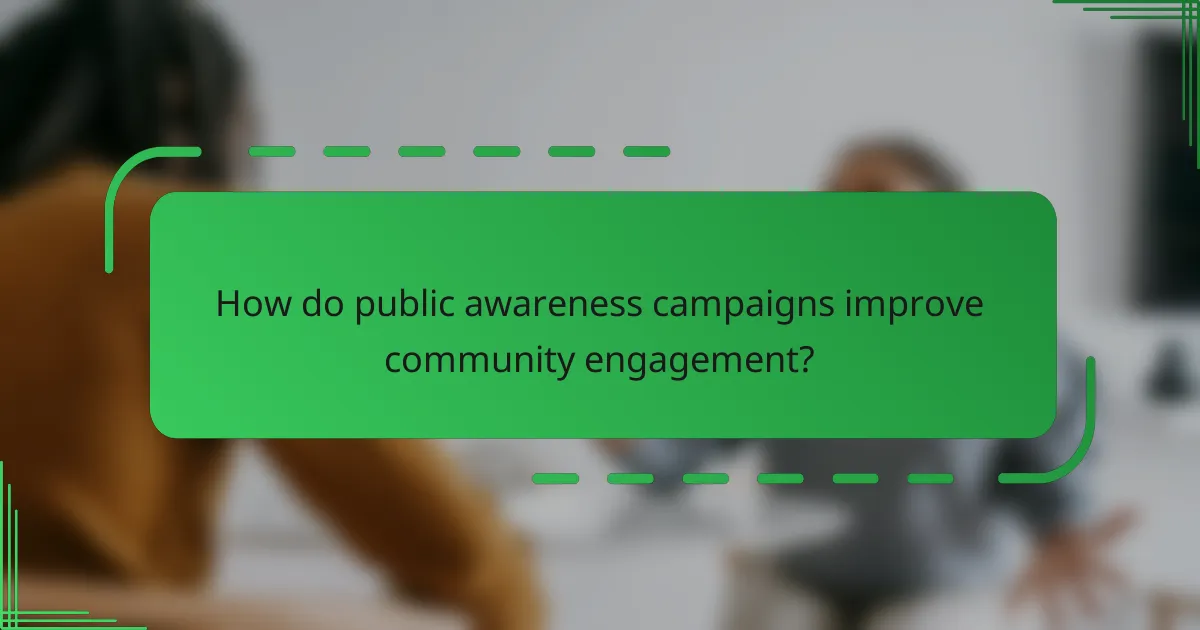
How do public awareness campaigns improve community engagement?
Public awareness campaigns enhance community engagement by fostering participation, improving communication, and building a sense of identity among residents. These campaigns effectively inform and motivate individuals to take part in local initiatives, creating a more connected and active community.
Increased participation in local events
Public awareness campaigns can significantly boost attendance at local events by promoting their benefits and encouraging community members to join. For instance, campaigns that highlight health fairs, cultural festivals, or town hall meetings can attract a wider audience, leading to increased involvement.
To maximize participation, campaigns should utilize various channels, such as social media, flyers, and community newsletters. Engaging visuals and clear calls to action can make a substantial difference in drawing people in.
Enhanced communication between residents and organizations
Effective public awareness campaigns create a bridge for communication between residents and local organizations. By disseminating information about services, resources, and opportunities, these campaigns help residents understand how to engage with their community.
Utilizing platforms like community forums, social media groups, and newsletters can facilitate ongoing dialogue. Encouraging feedback and questions from residents can further strengthen these connections, making organizations more responsive to community needs.
Strengthened community identity
Public awareness campaigns play a crucial role in fostering a strong community identity by celebrating local culture and values. When campaigns highlight unique aspects of a community, such as historical landmarks or local traditions, they help residents feel a sense of pride and belonging.
To reinforce community identity, campaigns can feature local stories, promote community achievements, and encourage participation in identity-building events. This approach not only unites residents but also attracts newcomers who appreciate the community’s character.
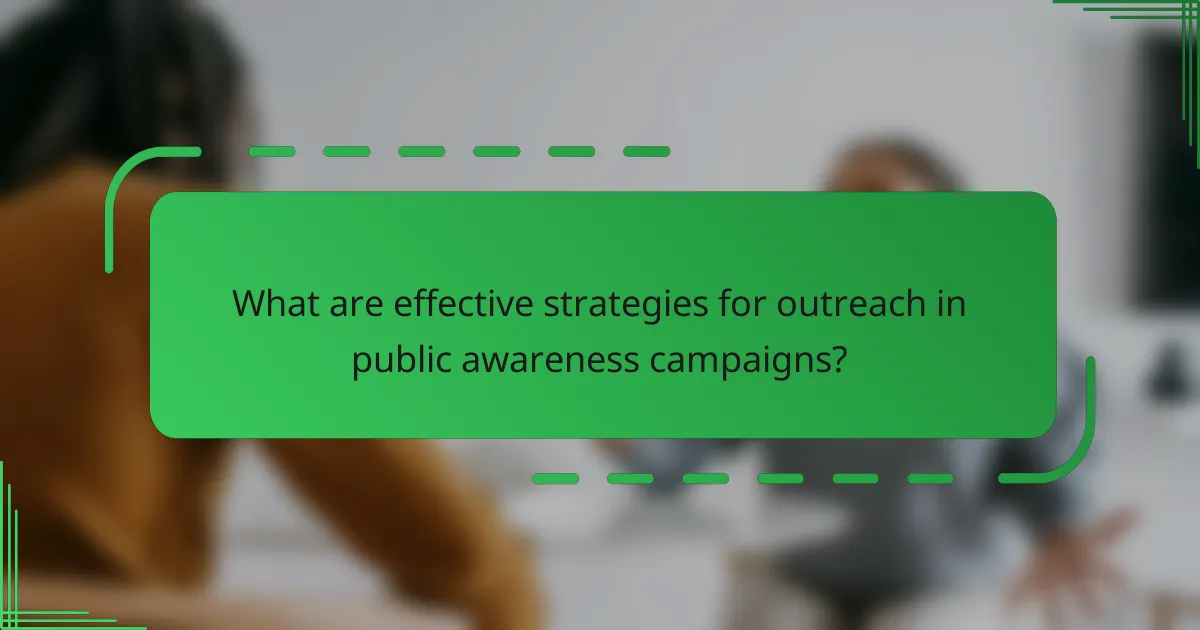
What are effective strategies for outreach in public awareness campaigns?
Effective outreach strategies in public awareness campaigns focus on engaging the target audience through various channels and methods. These strategies should be tailored to the community’s needs and preferences to maximize impact and participation.
Utilizing social media platforms
Social media platforms are powerful tools for outreach in public awareness campaigns. They allow organizations to reach a broad audience quickly and engage with community members directly through posts, stories, and live interactions.
To effectively use social media, identify the platforms most popular among your target demographic, such as Facebook, Instagram, or Twitter. Create shareable content, including infographics and videos, to increase visibility and encourage community sharing.
Hosting informational workshops
Informational workshops provide an interactive way to educate the community about specific issues. These events can foster dialogue, answer questions, and create a sense of community involvement.
When planning workshops, consider the venue, timing, and topics that resonate with your audience. Offering incentives like refreshments or materials can boost attendance and engagement. Aim for a mix of presentations and hands-on activities to cater to different learning styles.
Collaborating with local influencers
Partnering with local influencers can enhance the credibility and reach of public awareness campaigns. Influencers often have established trust within their communities, making their endorsement valuable.
Identify influencers who align with your campaign’s message and values. Collaborate on content creation, such as interviews or co-hosted events, to leverage their audience. Ensure that the partnership feels authentic to maintain trust with the community.
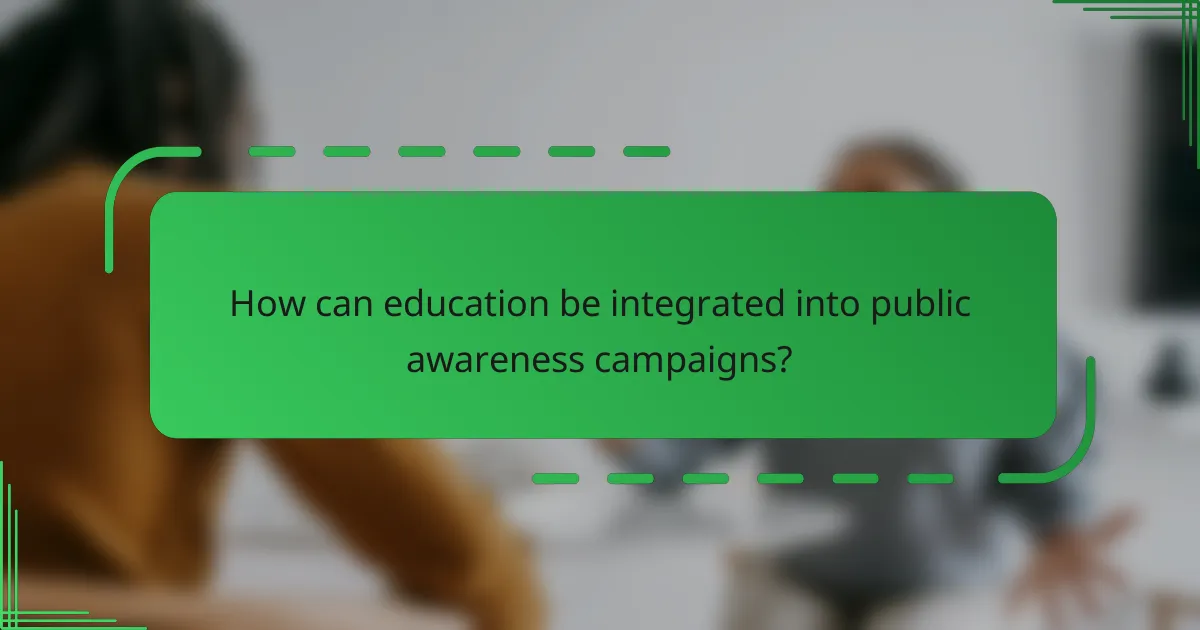
How can education be integrated into public awareness campaigns?
Education can be effectively integrated into public awareness campaigns by developing targeted materials, implementing programs in schools, and offering accessible online courses. These strategies enhance community understanding and engagement with important issues.
Creating educational materials
Developing educational materials is crucial for conveying key messages in public awareness campaigns. These materials can include brochures, flyers, infographics, and videos that simplify complex information into digestible formats. Ensuring that these resources are visually appealing and easy to understand increases their effectiveness.
When creating educational content, consider the target audience’s demographics and preferences. For example, using local languages and culturally relevant examples can significantly improve engagement and retention of information.
Implementing school programs
School programs serve as an effective platform for integrating education into public awareness campaigns. By collaborating with educational institutions, campaigns can introduce curriculum-based activities that align with local educational standards. These programs can cover topics such as health, environmental issues, or safety, fostering a sense of responsibility among students.
Engaging students through interactive workshops, presentations, and projects can enhance their understanding and encourage them to share knowledge with their families and communities. Schools can also host events that promote awareness, such as health fairs or environmental clean-up days.
Offering online courses
Online courses provide a flexible way to educate the public on various topics related to awareness campaigns. These courses can be designed to accommodate different learning styles and schedules, making them accessible to a broader audience. Platforms like MOOCs (Massive Open Online Courses) can be utilized to reach participants from diverse backgrounds.
When developing online courses, ensure that they are engaging and interactive, incorporating quizzes, videos, and discussion forums. Offering certificates upon completion can also motivate participants to enroll and complete the courses, further enhancing their knowledge and commitment to the campaign’s goals.
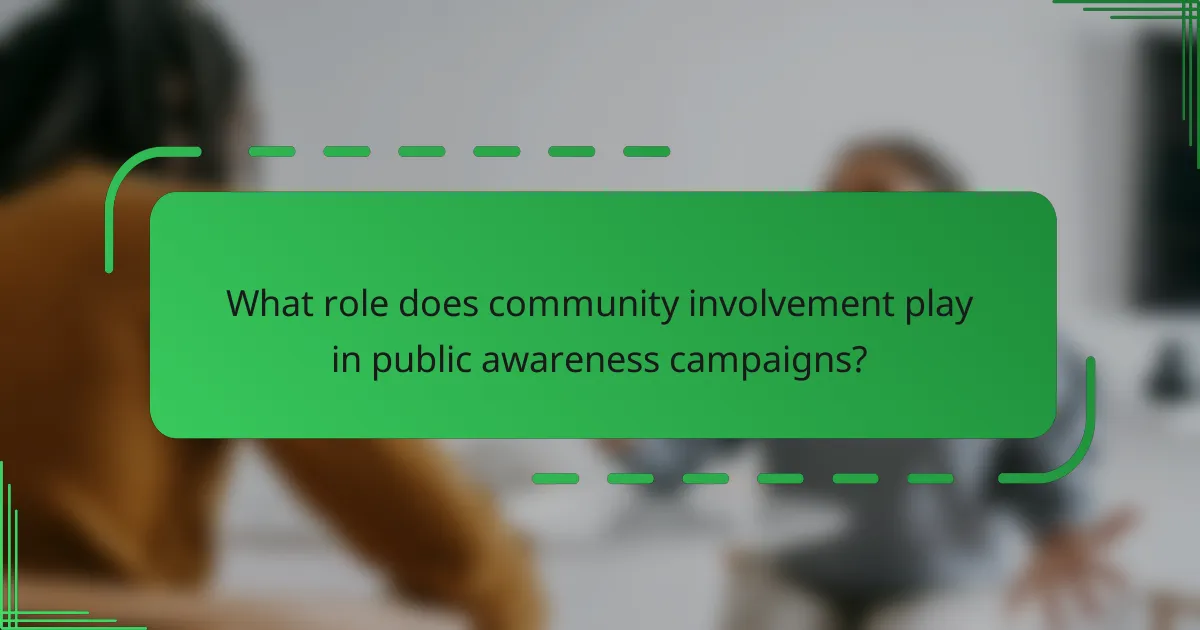
What role does community involvement play in public awareness campaigns?
Community involvement is crucial for the success of public awareness campaigns as it fosters engagement, builds trust, and enhances the campaign’s reach. By actively participating, community members can share their insights and experiences, making the campaign more relevant and effective.
Fostering volunteer opportunities
Creating volunteer opportunities allows community members to contribute directly to public awareness campaigns. This involvement not only helps in mobilizing resources but also empowers individuals by giving them a sense of ownership over the campaign’s goals.
To effectively foster volunteerism, organizations should clearly define roles and responsibilities, provide training, and recognize volunteers’ contributions. For instance, local health campaigns often recruit volunteers to distribute educational materials or assist in events, enhancing community engagement.
Encouraging local partnerships
Local partnerships can significantly amplify the impact of public awareness campaigns. Collaborating with schools, businesses, and non-profits can provide additional resources, expertise, and networks that enhance outreach efforts.
When forming partnerships, it is essential to align goals and ensure mutual benefits. For example, a campaign focused on environmental awareness might partner with local businesses to promote sustainable practices, creating a win-win situation that benefits both the campaign and the partners involved.
Gathering community feedback
Gathering community feedback is vital for understanding the effectiveness of public awareness campaigns. This feedback can help identify gaps in messaging and areas for improvement, ensuring that the campaign resonates with the target audience.
Methods for collecting feedback include surveys, focus groups, and community forums. Engaging with the community through these channels not only provides valuable insights but also fosters a sense of inclusion, making individuals feel valued and heard in the campaign process.

What are the key metrics for measuring campaign success?
Key metrics for measuring public awareness campaign success include participation rates and social media engagement. These metrics provide insight into how effectively the campaign is reaching and influencing its target audience.
Participation rates
Participation rates indicate the percentage of the target audience that actively engages with the campaign. This can be measured through attendance at events, completion of surveys, or involvement in activities related to the campaign.
To improve participation rates, consider offering incentives or making participation easy and accessible. For instance, hosting events in community centers or online can attract a wider audience.
Social media engagement
Social media engagement measures how well the campaign resonates with the audience on platforms like Facebook, Twitter, and Instagram. Key indicators include likes, shares, comments, and overall reach.
To enhance social media engagement, create shareable content that encourages interaction, such as polls or informative infographics. Regularly monitoring engagement metrics can help identify what content works best and guide future posts.
